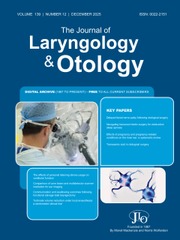No CrossRef data available.
Article contents
Beyond frequency: duration, intensity, and quality of life in Ménière’s disease
Published online by Cambridge University Press: 24 June 2025
Abstract
To analyse the evolution of the vertigo index and its relationship with perceived disability in unilateral and bilateral Ménière’s disease, assessing differences based on disease progression and clinical subtypes.
A longitudinal descriptive study was conducted on unilateral and bilateral Ménière’s disease patients, with data collected between 1977 and 2023 from two referral centres. Clinical and functional data were retrospectively reviewed to ensure compliance with updated diagnostic criteria. The vertigo index, integrating episode duration and frequency, quantified vertigo burden. Functional impact was assessed using the six-item American Academy of Otolaryngology Head and Neck Surgery disability scale, categorising patients into mild or moderate/severe disability groups.
Bilateral Ménière’s disease patients had a higher proportion of moderate/severe episodes (31.4 per cent) than unilateral Ménière’s disease patients (11 per cent). In unilateral Ménière’s disease patients, disability perception increased after 20 years of disease evolution. The vertigo index declined over time, except in later stages, where episodes were more disabling.
These findings underscore the need for long-term follow up, particularly in bilateral Ménière’s disease, where greater disability was observed. Disease management should adapt over time, addressing both vertigo burden and psycho-affective consequences.
Keywords
Information
- Type
- Main Article
- Information
- Copyright
- © The Author(s), 2025. Published by Cambridge University Press on behalf of J.L.O. (1984) LIMITED.
Footnotes
Tomàs Pérez-Carbonell takes responsibility for the integrity of the content of the paper
The meeting where it was presented was II REUNIÓN DE INVIERNO DE OTONEUROLOGÍA (RIO) in Madrid On February 21.Spain

